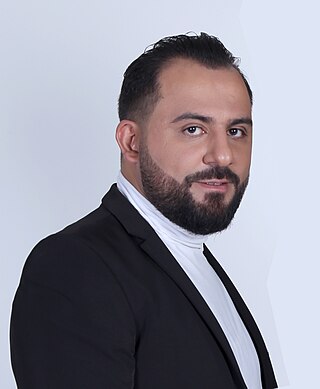
The culture of Armenia encompasses many elements that are based on the geography, literature, architecture, dance, and music of the Armenian people. Armenia is a majority Christian country in the Caucasus.

Silva Kaputikyan was an Armenian poet and political activist. One of the best-known Armenian writers of the twentieth century, she is recognized as "the leading poetess of Armenia" and "the grand lady of twentieth century Armenian poetry". Although a member of the Communist Party, she was a noted advocate of Armenian national causes.

The Mkhitar Heratsi Yerevan State Medical University, is an Armenian medical university located in Yerevan, Armenia.
Nairi was the Akkadian name for a region inhabited by a particular group of tribal principalities in the Armenian Highlands, approximately spanning the area between modern Diyarbakır and Lake Van and the region west of Lake Urmia. Nairi has sometimes been equated with Nihriya, known from Mesopotamian, Hittite, and Urartian sources. However, its co-occurrence with Nihriya within a single text may argue against this.

Aram Manukian, was an Armenian revolutionary, statesman, and a leading member of the Armenian Revolutionary Federation (Dashnaktsutyun) party. He is widely regarded as the founder of the First Republic of Armenia.
A wide array of sports are played in Armenia. Popular sports in Armenia include football, basketball, volleyball, and ice hockey. Further, the country sends athletes to the Olympics in boxing, wrestling, weightlifting, judo, gymnastics, track and field, diving, swimming, and shooting. Armenia's mountainous terrain provides great opportunities for the practice of sports like skiing and rock climbing. Being a landlocked country, water sports can only be practiced on lakes, notably Lake Sevan. Competitively, Armenia has been very successful at chess, weightlifting, and wrestling at the international level. Armenia is also an active member of the international sports community, with full membership in the Union of European Football Associations (UEFA), Federation of International Bandy (FIB), International School Sport Federation, International Ice Hockey Federation (IIHF), among others. It also hosts the Pan-Armenian Games.

Samvel Karapetian was an Armenian historian, researcher, author, and expert of medieval architecture, specializing in the study of the historical monuments of Armenia, Nagorno Karabakh and other regions of the Southern Caucasus.

Ruben Ter Minasian was an Armenian politician and revolutionary of the Armenian Revolutionary Federation (ARF) who played an important role in the Armenian national liberation movement and later in the First Republic of Armenia.

Tigran Khzmalyan is an Armenian politician and film director. Since 2018, Khzmalyan serves as the chairman of the European Party of Armenia. Since 2023, Khzmalyan serves as the chair of the Board of Trustees of PanEuropa Armenia.

Surb Karapet Monastery of Mush was an Armenian Apostolic monastery in the historic province of Taron, about 30 km (19 mi) northwest of Mush (Muş), in present-day eastern Turkey.

The History Museum of Armenia is a museum in Armenia with departments of Archaeology, Numismatics, Ethnography, Modern History and Restoration. It has a national collection of 400,000 objects and was founded in 1920. Of the main collection, 35% is made up of archaeology-related items, 8% is made up of ethnography-related items, 45% is made of numismatics-related items, and 12% is made up of documents. It is regarded as Armenia's national museum and is located on Republic Square in Yerevan. The state financially supports the museum and owns both the collection and the building. The museum carries out conservation and restoration work and publishes works on Armenian architecture, archaeology, ethnography, and history. They also have published a series of reports on archaeological excavations since 1948. The museum carries out educational and scientific programs on Armenian history and culture as well.
Haroutiun Galentz, also known as Kalents, was a prolific Armenian painter.
The following table is the list of urban areas with the largest Armenian population, including in Armenia and the disputed Republic of Artsakh (Nagorno-Karabakh), and the Armenian diaspora.
Armenian populations exist throughout the world. Although Armenian diaspora communities have existed since ancient times, most of the Armenians living outside of Armenia today are either descendants of Armenian genocide survivors or more recent immigrants from post-Soviet Armenia. According to various estimates, the total number of ethnic Armenians in the world is approximately 11 million, a majority of whom live outside of Armenia.

Mikayel Abrahamyan, known professionally as Misho, is an Armenian rapper and actor, best known as the pioneer of hip-hop music in Armenia.

Robert Elibekyan is an Armenian painter.

Grigor Danielyan, is an Armenian scriptwriter, producer, singer and actor. He has been working for Armenia TV company since 2004.
Ara Babloyan is an Armenian doctor pediatrician and politician, and the former President of the National Assembly of Armenia.

Ashough Jivani's House-Museum, Ashough Jivani's House-Museum in his native Kartsakhi village in Georgia. It was founded with the support of Javakheti Foundation in 2016. The opening ceremony took place in the framework of Jivani Day celebrations.

The Conservative Party is a political party in Armenia. It was founded in 1991.
























